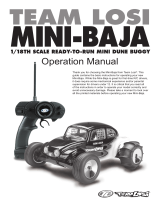
3
THINGS TO
KNOW
SAFETY PRECAUTIONS
When the safety precautions are followed, the
Evader EXT will provide years of enjoyment.
Use care and good sense at all times when
operating this radio controlled truck. Failure
to use this vehicle in a safe, sensible manner
can result in injury or damage to property.
You and you alone must insure that the
instructions are carefully followed and all
safety precautions are obeyed.
• Do not operate the Evader EXT near people.
Spectators should be behind the driver or
at a safe distance away from the vehicle.
• Make sure to read the instructions with the
battery and charger before charging.
• Do not leave any charger unattended
during charging. If the battery or charger
become hot at any time, disconnect the
battery from the charger immediately!
Failure to do so may cause permanent
damage to the charger and battery and
may cause bodily harm.
• Do not cover the air intake holes on the
charger during charging. This may cause
the charger to overheat.
• Do not allow the electronic speed control
(ESC) or radio equipment to come into
contact with moisture. Water can cause
the electronics to short out and can cause
permanent damage.
• Always turn on the transmitter before
turning on the electronic speed control.
• Before turning on your radio, check to
make sure that no one else is running on
the same frequency as your Evader EXT.
HELPFUL HINTS
• Avoid working over a deep pile carpet. If
you drop a small part or screw, it may be
diffi cult to fi nd.
• Place a mat or towel over your work area.
This will prevent parts from rolling off and
will protect the work surface.
• Avoid running the truck in cold weather. The
plastic and metal parts can become brittle
at low temperatures. In addition, grease
and oil become thick, causing premature
wear and poor performance.
• Test fi t all parts before attaching
them permanently.
SPECIFICATION AND
DESCRIPTION CHANGES
All pictures, descriptions and specifi cations
found in this instruction manual are
subject to change without notice. DuraTrax
maintains no responsibility for inadvertent
errors in this manual. Visit www.duratrax.
com for the latest updates and information
for your model.
WARRANTY
• DuraTrax
®
guarantees this kit to be
free from defects in both material and
workmanship at the date of purchase.
DuraTrax will warranty this kit for 90
days after the purchase date. DuraTrax
will repair or replace, at no charge, the
incorrectly made part.
• Make sure you save the receipt or invoice
you were given when you bought your
model! It is your proof of purchase and
we must see it before we can honor the
warranty. Further, DuraTrax reserves the
right to change or modify this warranty
without notice.
• In that DuraTrax has no control over the
fi nal user assembly or material used for
fi nal user assembly, no liability shall be
assumed nor accepted for any damage
resulting from the use by the user of the
fi nal user-assembled product. By the act
of using the user-assembled product, the
user accepts all resulting liability.
To return your Evader EXT for repairs covered
under warranty you should send your truck to:
Hobby Services
3002 N. Apollo Drive Suite 1
Champaign, Illinois 61822
Attn: Service Department
Phone: (217) 398-0007 9:00 am-5:00 pm
Central Time M-F
E-mail: hobbyservices@hobbico.com
www.hobbyservices.com
If the buyer is not prepared to accept the
liability associated with the use of this
product, the buyer is advised to return
this kit immediately in new and unused
condition to the place of purchase.
STRESS-TECH
™
PARTS
GUARANTEE
We have engineered the Evader EXT to
take the rough and tumble abuse that makes
R/C fun. We are so confi dent of the quality
and durability of the Stress-Tech plastic
parts that we will replace any Stress-Tech
plastic part you break during the fi rst 12
months you own the truck. Just send in the
part to us and we will send you a FREE
replacement. Please see the Evader EXT
parts list for the items covered under the
Stress-Tech guarantee.
To receive your free replacement part
please send the following to the Hobby
Services address listed under the warranty
on the left.
❏ 1. The broken part must be included.
❏ 2. The part number and description of the
broken part.
❏ 3. Copy of your dated invoice or
purchase receipt.
❏ 4. Your name, phone number and
shipping address.
REPAIR SERVICE
Repair service is available anytime.
• After the 90 day warranty, you can still
have your Evader EXT repaired for a
small charge by the experts at DuraTrax’s
authorized repair facility, Hobby Services.
• To speed up the repair process, please
follow the instructions listed below.
❏ 1. Under most circumstances return
the ENTIRE vehicle. The exception would
be sending in a Stress-Tech part. See the
instruction under the Stress-Tech Guarantee.
❏ 2. Make sure the transmitter is turned off,
and all of the batteries are removed.
❏ 3. Send written instructions which include:
a list of all items returned, a THOROUGH
explanation of the problem, the service
needed and your phone number during the
day. If you expect the repair to be covered
under warranty, be sure to include a proof
of date of purchase (your store receipt or
purchase invoice).


















